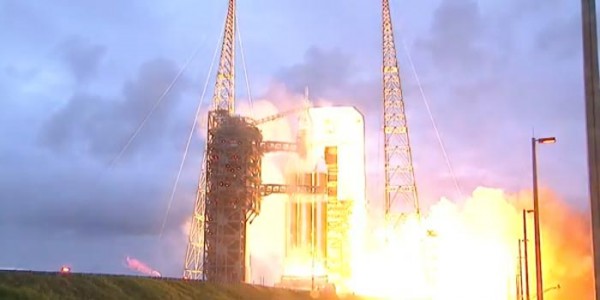Purdue Payload Flew On Orion Test Flight
Items representing Purdue University’s contributions to flight and space history flew onboard this week’s first test of Orion from Cape Canaveral Air Force Station’s Space Launch Complex. Purdue is the alma mater of 23 NASA astronauts.
The Orion flight test, a two-orbit, four-hour flight that tested many of the systems most critical to safety, was scheduled for Thursday, Dec. 4. Due to weather and other complications, the launch was tentatively rescheduled for Friday morning. [EDITOR’S NOTE: The Orion Flight Test was successfully launched Friday morning. See video below.] The test evaluated launch and high-speed re-entry systems such as avionics, attitude control, parachutes and the heat shield.

This photo of Purdue alumni astronauts Neil A. Armstrong (left) and Gene A. Cernan, will be aboard the Orion space vehicle. The photo is from a 2007 football game in Purdue’s Ross-Ade Stadium. (Purdue University photo)
As part of the flight, Purdue University Libraries’ Division of Archives and Special Collections provided a group photograph taken at the university’s 1999 Purdue astronaut reunion. Also included was a photograph of Neil Armstrong and Eugene Cernan, the first and last men to walk on the moon, raising the American flag acknowledging a cheering crowd at Purdue’s Ross-Ade Stadium in 2007.
Lastly, two Purdue pennants were on board. These items represent Purdue’s contributions to the US space program – by not only its astronauts but also by the generations of engineers and scientists who have graduated from Purdue and gone on to work for NASA and in the aerospace industry.
“Purdue has long had a prominent presence in the US space program, and it’s gratifying that our university is part of this historic occasion,” said Purdue President Mitch Daniels.

The Orion test flight will carry this photo of Purdue alumni astronauts into space. The photo was taken during their reunion on Purdue’s campus in 1999. (Purdue University photo)
NASA’s Orion spacecraft was built to take humans farther than they’ve ever gone before. Orion will serve as the exploration vehicle that will carry the crew to space, provide emergency abort capability, sustain the crew during the space travel, and provide safe re-entry from deep space return velocities.
In the future, Orion will launch on NASA’s new heavy-lift rocket, the Space Launch System. More powerful than any rocket ever built, SLS will be capable of sending humans to deep space destinations such as an asteroid and eventually Mars. Exploration Mission-1 will be the first mission to integrate Orion and the Space Launch System.

